What are the best thermal imaging cameras?
This is a type of device that can be used to detect the heat energy of an object and thus learn its temperature. The best thermal camera is typically small enough to be held in hand and has a screen that shows a map of infrared radiation emitted by objects. With it, you can estimate their temperature.
A small IR camera is a great way of detecting issues with electrical or mechanical applications and the insulation of buildings. You can detect places where the energy or heat is leaking, some moisture is penetrating, or a device is overheating.
If a device like that would be useful in your work or some other activity, select one among the greatest options below but first make sure you know the features you need the most.
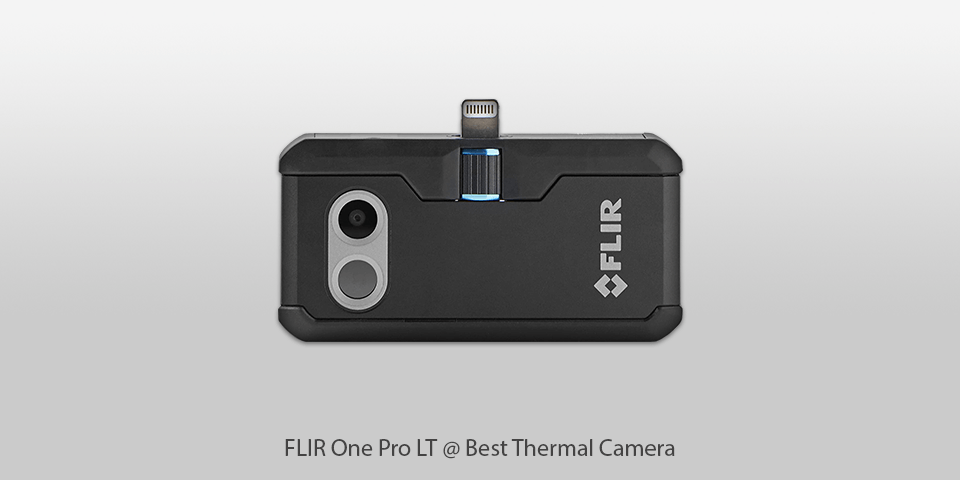
Thermal Resolution: 80x60 pixels | Spectral Range: 8-14 µm | Sensitivity: 100 mK | Field of View (HxV): 50°x38° | Frame Rate: 8.7 Hz | Battery Life: Approximately 1 hours | Display: no | Weight: 36.5 g
⊕ Functional thermal imaging
⊕ Helpful software features
⊕ Quick recharge
⊕ Adjustable 4 mm connector
⊖ Misbehaves on IOS devices
⊖ Somewhat limited in the temperature range
This is the best thermal camera for any kind of worker dealing with plumbing, wiring or construction. It operates on a unique technology that can enhance the image during processing and produce higher accuracy and quality on the outcome.
The camera is reliable for diagnosing problems and has a helpful app for solving issues better and increasing the device’s functionality. It can double as a level/span control and a spot meter, plus it is not afraid of the conditions of a construction site and can easily survive a 1.8-meter fall.
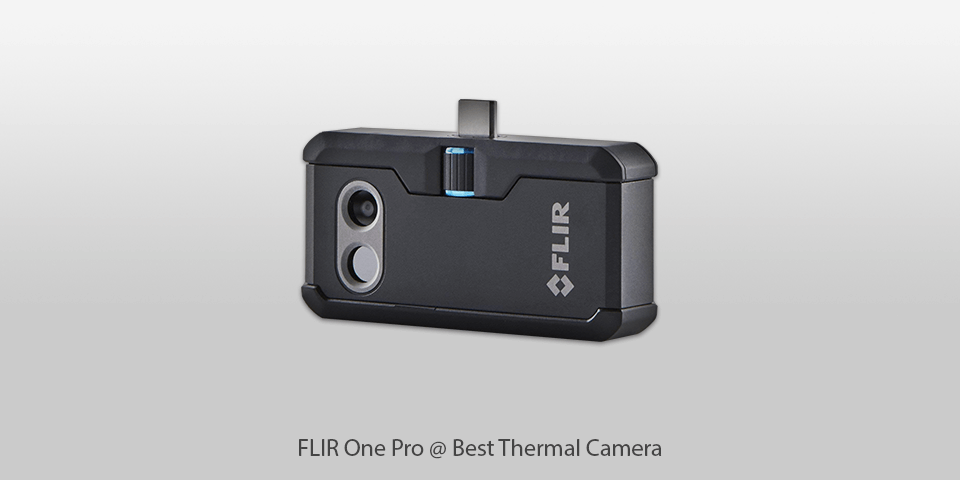
Thermal Resolution: 160x120 pixels | Spectral Range: 8-14 µm | Sensitivity: 70 mK | Field of View (HxV): 55°x43° | Frame Rate: 8.7 Hz | Battery Life: Approximately 1 hours | Display: no | Weight: 36.5 g
⊕ Ergonomic and portable
⊕ Super-extended temperature range
⊕ MSX and VividIR technologies
⊕ Adaptive connector
⊖ Small battery capacity
⊖ Unreliable software
If you are searching for the best thermal imaging camera to go with an Android device, here is a great one. It combines an optical resolution of 1440×1080 with a thermal one of 160x120 and thus produces quite impressive results. If a living creature is as far as 130 feet away, you will be able to see it.
The optical results are further enhanced by the VividIR technology that is capable of increasing clarity and bringing out some details. Another technology called MSX can overlay the different results of the two optical components and produce a more informative outcome.
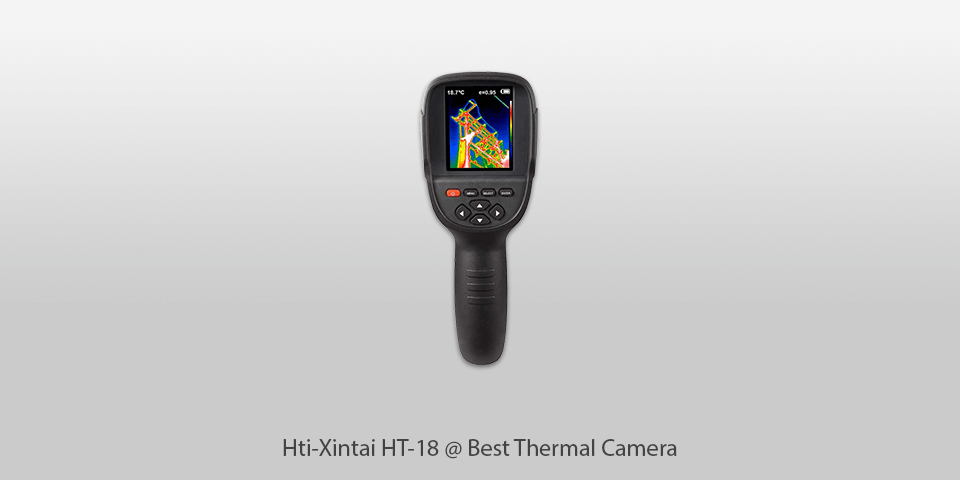
Thermal Resolution: 220x160 pixels | Spectral Range: 8-14 µm | Sensitivity: 70 mK | Field of View (HxV): 35°x27° | Frame Rate: 8 Hz | Battery Life: no information | Display: 3.2" TFT LCD | Weight: 380 g
⊕ Fit for professional application
⊕ High-resolution imagery
⊕ 3GB of storage
⊕ Lightweight, easy to hold
⊖ Underwhelming sensitivity
⊖ Somewhat confusing interface
If you need the best infrared camera for locating heat leaks or wiring issues, make note of this option. It produces visuals of impressive quality and can cover many work hours with its great battery life.
It is equipped with a full-color 3.2-inch screen and produces thermal imagery in 220x160 resolution. That can be recorded onto the 3 GB of internal storage.
Whenever you need a higher accuracy of measurements, adjust the emissivity to match the task. The device is shaped like a gun and has a convenient handle for lengthy inspecting jobs. It has a pouch for storage and weighs only 0.83 pounds, perfect for an on-call specialist.
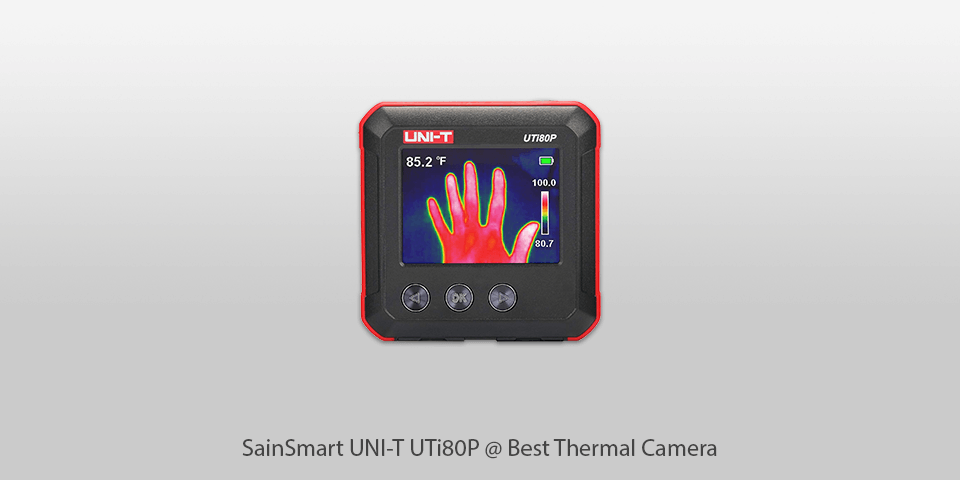
Thermal Resolution: 80x60 pixels | Spectral Range: 8-14 µm | Sensitivity: 150 mK | Field of View (HxV): 51°x38° | Frame Rate: 9 Hz | Battery Life: Approximately 3-4 hours | Display: 2.4” TFT LCD | Weight: 125 g
⊕ Transportable
⊕ Precise and adjustable
⊕ Provides efficiency of inspecting
⊕ Three color palettes
⊖ Unsatisfactory thermal resolution
⊖ Battery feels underpowered
Many thermal imaging camera reviews commend this particular model as a handy troubleshooting tool. It can process the whole range of emissivity frequency and the imprecision will only be two percent or degrees.
This way, you can caliber it to work with metals, walls or other surfaces. Its color palettes are also adjustable and can be set to particular scenes.
The camera has a processor for analyzing data and you can see it on the small display or connect a bigger device via USB to have a better result. It can also be recorded on the 16 GB of internal memory for further work which the rechargeable battery makes much more convenient.
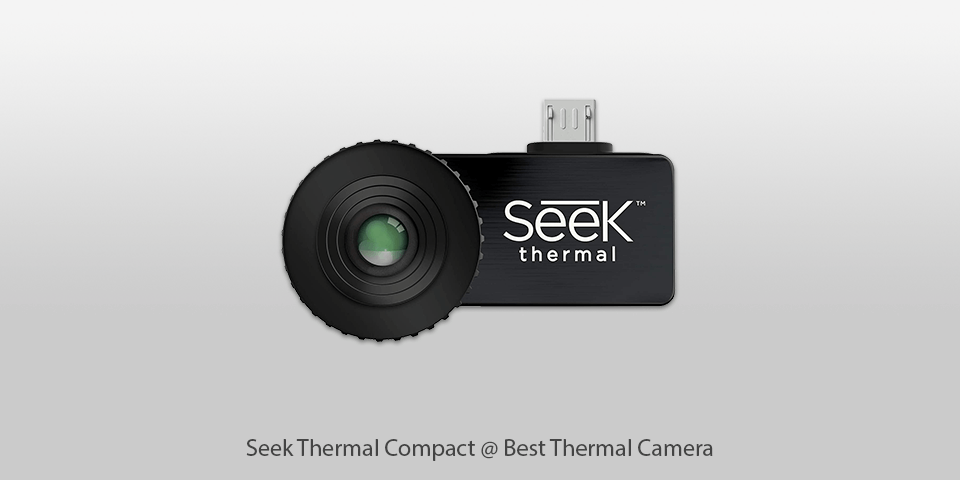
Thermal Resolution: 206x156 pixels | Spectral Range: 7.5-14 µm | Sensitivity: 75 mK | Field of View (HxV): 36° | Frame Rate: 9 Hz | Battery Life: Powered by smartphone | Display: no | Weight: 14 g
⊕ Convenient in transportation
⊕ Eliminates the need for charging
⊕ Supplied with a waterproof case
⊕ Free application with settings
⊖ Grainy images
If you want the best thermal imager to just keep in your bag for unexpected cases, this incredibly lightweight but high-quality device is the perfect candidate. As it does not work with the light, it can recognize objects and the heat they radiate even in the dark.
Its thermal range is -40 to 626 degrees Fahrenheit so you will hardly require more. A full-size device will give you a clearer picture but compared to the portable ones it works great and can be stored away in its rubberized case when not in use.
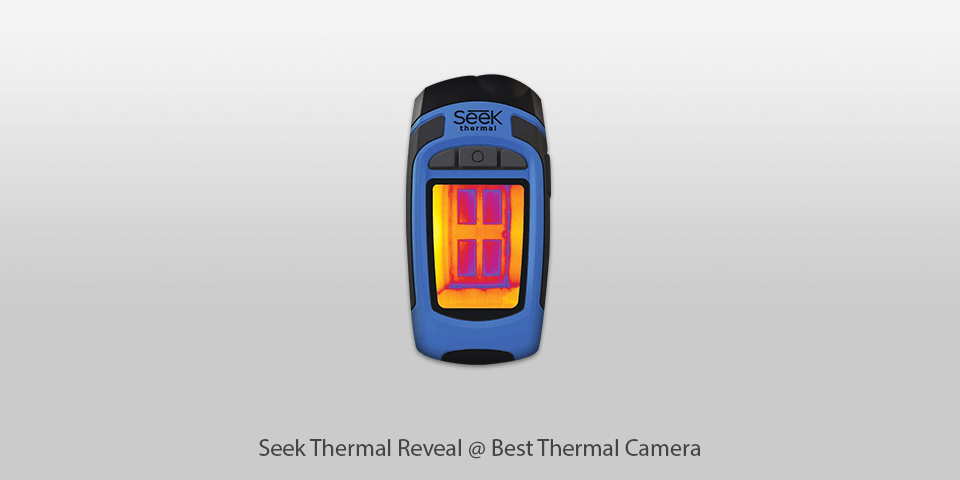
Thermal Resolution: 206x156 pixels | Spectral Range: 7.5-14 µm | Sensitivity: 70 mK | Field of View (HxV): 36° | Frame Rate: 9 Hz | Battery Life: Up to 10 hours | Display: LCD | Weight: 177 g
⊕ Allows extending memory
⊕ Well-organized interface
⊕ Durable rechargeable battery
⊕ LED flashlight
⊖ Can not produce footage
The ergonomic and angled build of this IR camera makes targeting objects and tracking the thermal outcome incredibly easy. A single charge can provide 10 hours of uninterrupted image processing.
Its optics captures 36 degrees of width and shows the temperatures at a resolution of 206x156 pixels. When the light is insufficient, you can turn the 300 lumen LED flash on and improve the results. The reach of this device is up to 500 feet so you can reveal faraway objects with ease.
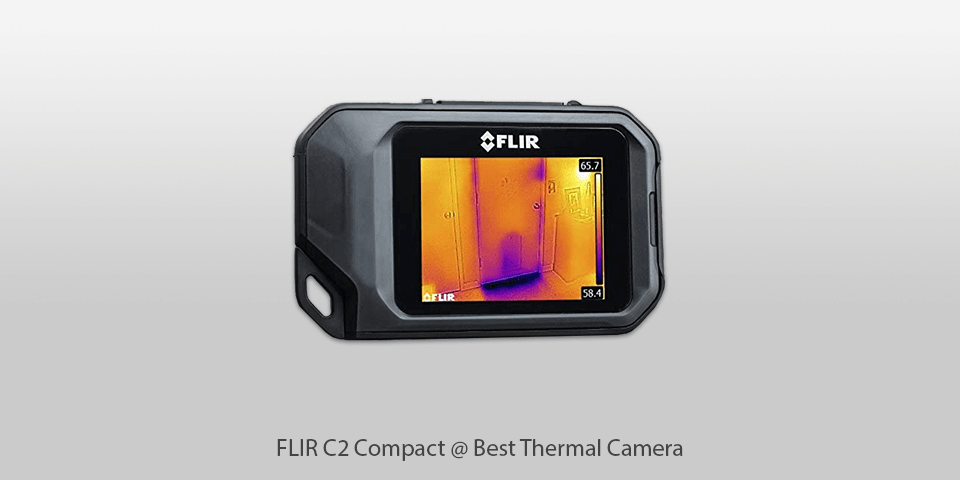
Thermal Resolution: 80x60 pixels | Spectral Range: 7.5-14 µm | Sensitivity: 100 mK | Field of View (HxV): 41°x31° | Frame Rate: 9 Hz | Battery Life: Up to 2 hours | Display: 3" LCD | Weight: 130 g
⊕ A compact, transportable body
⊕ MSX technology
⊕ Extended field of view
⊕ FLIR Tools application
⊖ Not the best battery
⊖ High price
Whatever the sensor of the best thermal camera picks up gets depicted in much detail on the vibrant 3-inch touchscreen. Assisted by the LED spotlight, it ensures the highest quality so that you can efficiently carry out troubleshooting. The device can capture half a thousand radiometric images and the sensor can reach the quality of 4800 px.
You can benefit from the brand’s unique MSX technology that pulls the details out of the data recorded with the visible light camera and merges it with the infrared outcomes in real-time. The software of the camera can give you even more interesting and helpful features for fine-tuning the device.
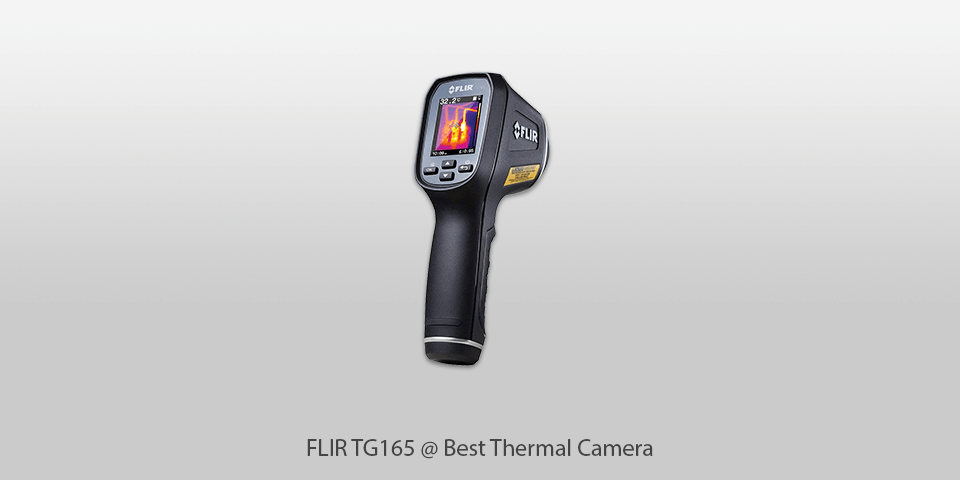
Thermal Resolution: 80x60 pixels | Spectral Range: 8-14 µm | Sensitivity: 150 mK | Field of View (HxV): 50°x39° | Frame Rate: 9 Hz | Battery Life: Up to 5 hours | Display: 2" TFT LCD | Weight: 312 g
⊕ Robust and portable
⊕ Precise in measurements
⊕ Laser targeting
⊕ Wide-angled optics
⊖ Visuals could be better
⊖ Limited to 2 color palettes
Those who require the best budget thermal imaging camera in terms of precision should consider this option. The camera uses two laser pointers directed to one spot to collect more thermal data, and this is a better way of analyzing circuit boxes, switches and other complex objects.
The device has the 50-degrees world field of view and represents the thermal findings in an 80×60 pixel image. With its imaging engine, you can expect to have a decent working resolution. The internal capacity of 8 GB can hold an impressive number of 75,000 images. The battery can last for five hours of uninterrupted laser scanning.
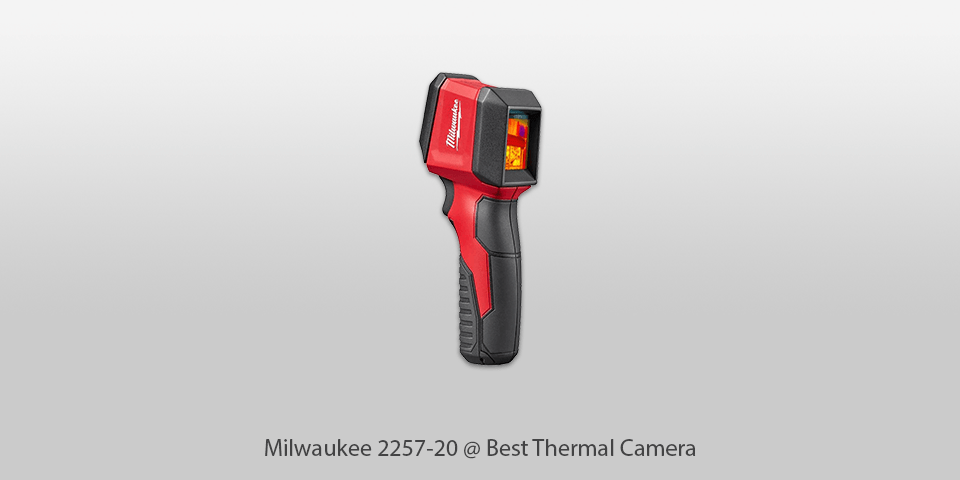
Thermal Resolution: 102x77 pixels | Spectral range: 7.5-14 µm | Sensitivity: 100 mK | Field of View (HxV): 37°x27° | Frame Rate: 8 Hz | Battery Life: no information | Display: 1.8" LCD | Weight: 204 g
⊕ Sturdy and convenient shell
⊕ Clear image displayed
⊕ DualSense technology
⊖ Not provided with storage
⊖ Battery replacement isn’t tool-free
Another best infrared camera option is a robust device with a great technology that eliminates the blurring of temperature readings. It claims to have 56:1 distance to spot performance and can recognize a 14°– 626°F range of temperatures.
You can scan, aim and obtain a precise value regardless of your proximity to the object. The screen will hold that result for 15 seconds, showing in 102x77 resolution, allowing you to check a big area efficiently. The camera runs on a 9v battery and its installation is the only thing required to start working.
| Image | Name | Features | |
|---|---|---|---|
 |
FLIR One Pro LT
Our Choice |
CHECK PRICE → | |
 |
FLIR One Pro
For Android |
CHECK PRICE → | |
 |
Hti-Xintai HT-18
Infrared |
CHECK PRICE → |

It’s always crucial for a camera to deliver a high-quality thermal image, as it allows you to detect heat-loss areas with better accuracy. If your device has a high resolution, you will be able to zoom into the object and get better results. As for a lower limit, try to purchase a model that has a resolution of at least 4800 pixels.
Some users have the need to compare the thermal image to the light one in order to receive clearer findings. Some cameras have a separate feature for highlighting that can show you the difference between the two images in particular. This feature will much facilitate the process for anyone working with such measurements.
This value tells you how small of a temperature difference the device can recognize. You can see it marked as NETD and the value can be indicated in mK or °C and sometimes both.
If you see 100mK (0.10°C), this is considered adequate when the accuracy does not exceed five percent or degrees of deviation. For excellent results, thermal imaging reviews suggest halving that value, so seek a 50mK (0.05°C) marking or lower, where the deviation will only constitute two degrees or percent.
Having a wider range is good but this always increases the cost of the device. If you have a limited budget, just get the best you can afford. If capturing various temperature anomalies is crucial, prepare to pay extra and mind the thermal sensitivity for the highest precision.

Normally, you will see devices with a 3-inch screen available, and they work fine. Yet again, for higher precision, it is better to get a device with a 5-7-inch screen. This increases your capability to detect problems and defects and provides you with a finer image to analyze.
With the use of infrared light, a thermographic camera can capture the temperature of any object in its range. Humans can’t see the IR radiation, but we can sometimes perceive it as heat because that is the way it transfers. Since any object normally radiates some IR light, the camera can show its intensity on the screen.
Unfortunately, experts concluded that measuring temperature from a distance, which is what fever detecting systems do, might not be efficient enough. The most precise cameras still have an estimation error of about 2 degrees Celsius (nearly 4 in Fahrenheit).
The device itself can do no harm to people but considering the range of activities where its measurements are required, some danger can sometimes be connected to its use. If you are inspecting electrical, heating equipment, or do some similar activity, take all the necessary precautions.
Yes, you can install the best thermal camera for iPhone or Android through the system’s app store. Among the most popular ones, you will find CompactXr, Flir One and ThermApp.

 Rating
Rating